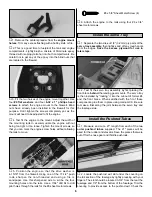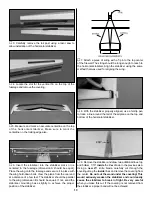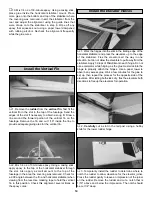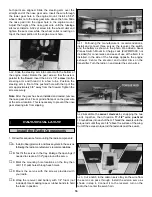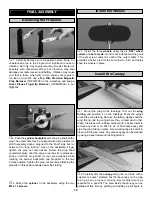
The engine gets hot! Do not touch it during or after
operation. Make sure fuel lines are in good condition so
fuel will not leak onto a hot engine causing a fire.
To stop the engine, cut off the fuel supply by closing off the
fuel line or follow the engine manufacturer's
recommendations. Do not use hands, fingers or any other
body part to try to stop the engine. Do not throw anything
into the propeller of a running engine.
The Great Planes Easy Sport is a great flying sport airplane
that flies smoothly and predictably, yet is highly
maneuverable. It does not, however, have the self-recovery
characteristics of a primary R/C trainer; therefore, you must
either have mastered the basics of R/C flying or obtained
the assistance of a competent R/C pilot to help you with
your first flights.
If you have dual rates on your transmitter, set the switches
to “high rate” for takeoff, especially when taking off in a
cross wind. Although the Easy Sport has great low speed
characteristics, you should always build up as much speed
as your runway will permit before lifting off, as this will give
you a safety margin in case of a “flame-out.” When the
plane has sufficient flying speed, lift off by smoothly
applying a
little
up elevator and climb out gradually.
We recommend that you take it easy with your Easy Sport
for the first several flights and gradually “get acquainted”
with this fantastic airplane as your engine gets fully broken-
in. Add and practice one maneuver at a time, learning how
she behaves in each one. For ultra-smooth flying and
normal maneuvers, we recommend using the “low rate”
settings as listed on page 20. If you notice any
“sluggishness” in the way your Easy Sport handles, it is
probably a result of not enough speed, in which case you
should install a propeller with increased pitch.
When it's time to land, fly a normal landing pattern and
approach. If you find that it lands a little fast, you might try
dialing in a few clicks of up elevator when you cut the
throttle on the downwind leg of the landing pattern. This will
automatically help to bleed off some of the speed. If your
Easy Sport is built straight and true, you'll find that you can
really flare it out for slow, nose-high, full-stall landings
without fear of tip stalling.
Have a ball, but always stay in control and fly in a safe
manner.
GOOD LUCK AND GREAT FLYING!
Landing
Flight
CAUTION
(THIS APPLIES TO ALL R/C AIRPLANES): If,
while flying, you notice any unusual sounds, such as a
low-pitched “buzz”, this may indicate control surface
“flutter”. Because flutter can quickly destroy components
of your airplane, any time you detect flutter you must
immediately
cut the throttle and land the airplane!
Check all servo grommets for deterioration (this may
indicate which surface fluttered) and make sure all
pushrod linkages are slop-free. If it fluttered once, it will
probably flutter again under similar circumstances unless
you can eliminate the slop or flexing in the linkages. Here
are some things which can result in flutter: Excessive
hinge gap; Not mounting control horns solidly; Sloppy fit
of clevis pin in horn; Elasticity present in flexible plastic
pushrods; Side-play of pushrod in guide tube caused by
tight bends; Sloppy fit of Z-bend in servo arm; Insufficient
glue used when gluing in the elevator joiner wire or
aileron torque rod; Excessive flexing of aileron, caused
by using too soft balsa; Excessive “play” or “backlash” in
servo gears; and Insecure servo mounting.
Takeoff
FLYING
22

